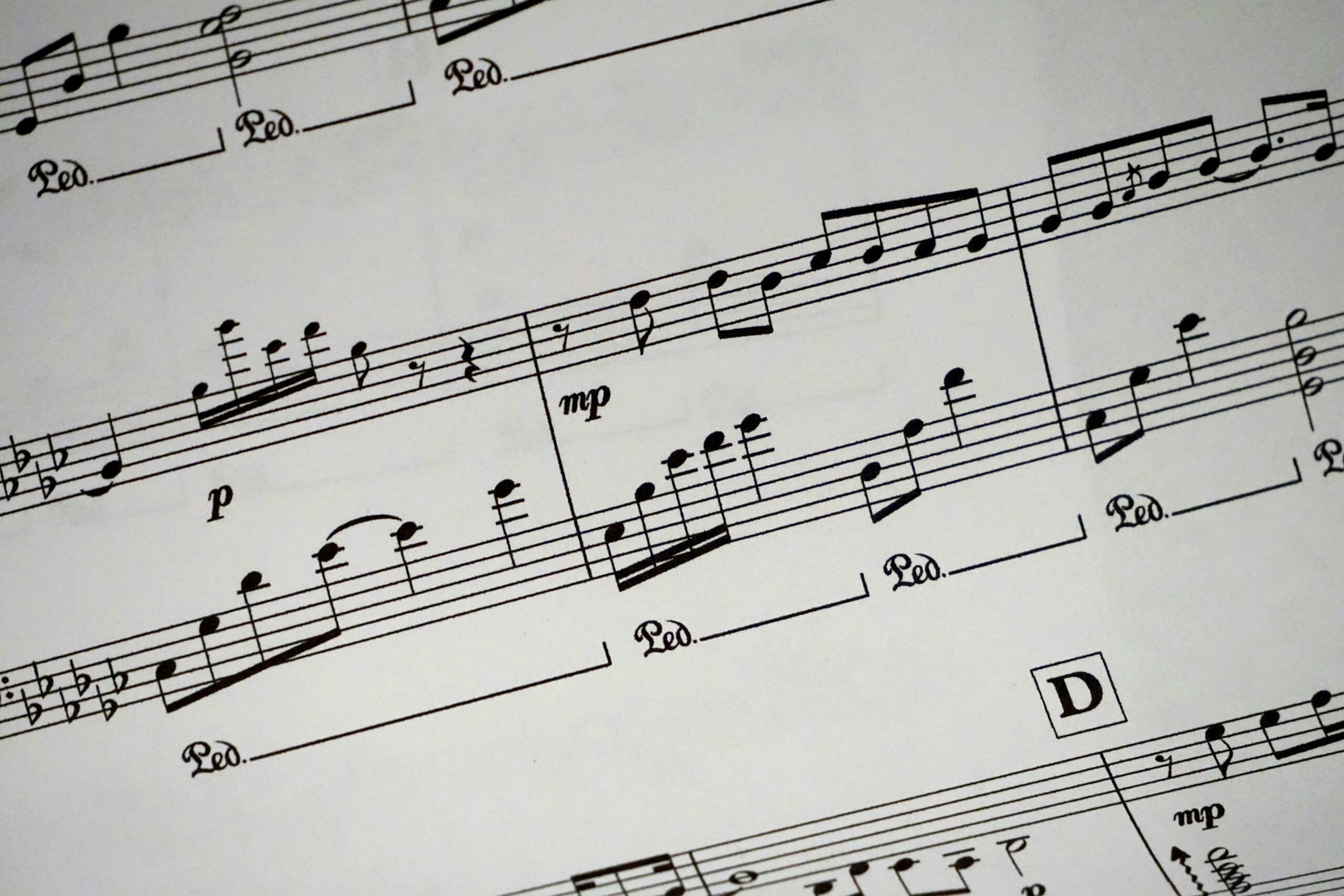
Maths in Music: Discover How Awesome Numbers and Patterns Shape Tunes
Table of Contents
Maths in Music: The intricate relationship between mathematics and music is both fascinating and complex, encompassing a wide array of principles from patterns and forms to ratios and symmetry. In composing music, the mathematical foundations are not always overt, yet they underpin the structure and aesthetics of the melodies and rhythms that resonate with us. While the connection may seem abstract at a glance, music often relies on mathematical concepts to create harmony, develop motifs, and express ideas in a structured yet creative way.

We discover that the construction of scales, chord progressions, and rhythmic patterns involves numerical relationships. The symmetry and fractals found in music compositions are just as much mathematical phenomena as they are musical ones. Composers have long used mathematical principles, whether consciously or intuitively, to construct compositions that have the power to move us. Through exploring this fascinating nexus, we not only gain insights into the creative processes of influential composers and musicians, but also enhance the ways in which music can be taught and understood.
Key Takeaways
- Mathematics is deeply intertwined with music, influencing its structure and beauty.
- Numerical relationships and patterns form the basis of musical composition.
- Studying the math-music connection enhances our understanding and teaching of both disciplines.
Foundations of Maths in Music
We find the relationship between maths and music profoundly intertwined, where foundational principles of mathematics reveal themselves in musical composition. This nexus can be observed from the very scales and notes that constitute music. Let us explore the integral role of maths in these elements of music.
Mathematical ratios serve as the bedrock for constructing musical scales. From ancient times, figures like Pythagoras used ratios to describe the intervals between notes. By dividing strings into fractions, he demonstrated that sound frequencies produce harmonious tones when the ratios between them are simple.
Consider the octave, where the frequency ratio between the lower and higher note is 2:1. Within this octave, the musical scale system divides these frequencies further into notes. The western diatonic scale consists primarily of whole steps and half steps—intervals that conform to precise mathematical patterns.
An example of the significance of these ratios is illustrated in the creation of an A major scale:
- Note A (root): Frequency 440 Hz
- Note B: Frequency 440 Hz × (9/8) = 495 Hz (whole step)
- Note C♯: Frequency 440 Hz × (5/4) = 550 Hz (whole step)
- Note D: Frequency 440 Hz × (4/3) = 586.67 Hz (half step)
- And so on…
This pattern of whole and half steps, following a specific sequence, results in a scale that we perceive as pleasing to the ear.
Here’s a simplified representation of a scale in terms of whole (W) and half (H) steps:
| Note | W | W | H | W | W | W | H |
|---|---|---|---|---|---|---|---|
| A | B | C♯ | D | E | F♯ | G♯ | A |
Beyond scales, intricate patterns and numerical concepts are present in rhythmic structures and the complex polyrhythms of modern compositions.
Understanding the foundational maths in music allows us to appreciate not just the acoustic allure of melodies and harmonies but also the exquisite mathematical framework that underpins our musical experiences.
Musical Patterns and Mathematical Form
In music composition, we often see a beautiful interplay between structure and creativity. Mathematical concepts help us imbue our music with intricate patterns that enhance rhythm, melody, and harmony.
Rhythmic Structures
We use rhythmic structures to organise time in music. Typically, we divide time into periodic segments called measures, which house a set number of beats. These beats can be further grouped into various subdivisions to create diverse rhythmic patterns. The repetition and variation within these patterns often reflect mathematical principles, imparting a distinct feel and character to a musical piece.
Melodic Sequences
Melodic sequences are formed when a motif or phrase is repeated at different pitches. We apply specific intervals to shift these sequences, adhering to mathematical ratios that maintain a consistent structure within the melody. This method not only results in aesthetically pleasing sequences but also ensures that the melodic progression feels natural to the listener.
Harmonic Patterns
Harmonic patterns emerge from the deliberate combination of notes to create chords. Each chord follows a mathematical formula based on the intervals between its notes. The progression of chords, or the harmonic structure, relies on a pattern of these intervals, often leading to a recognisable form within the music. These patterns can induce tension and resolution, thereby guiding the emotional journey of the piece.
Mathematical Principles in Composition
In the realm of music, we often explore the profound connection between numbers and melody. Mathematical principles are not just abstract concepts but serve as foundational tools that composers use to create intricate musical works.
The Role of Numbers and Ratios
Numbers and ratios lie at the heart of musical theory, shaping the way we perceive harmony and melody. The Greek mathematician Pythagoras was one of the first to establish the relationship between simple ratios and musical intervals, which today serves as a cornerstone in the composition of music. For instance, an octave is understood as a 2:1 ratio, while a perfect fifth is a 3:2 ratio. These precise relationships allow us to predictably create harmony and are integral to the structure of scales and chords in composition.
Mathematical Transformations in Music
Transformation in music composition can take a variety of forms, often grounded in mathematical principles. For example, composers might employ geometric transformations to invert melodies or to create retrograde versions by reversing note sequences. These mathematical manipulations not only diversify the auditory experience but also challenge and enrich traditional compositional practices. Serialism is another technique where numbers and sequences, as mathematical elements, determine the order of pitches, dynamics, and rhythms to generate complex and often atonal pieces.
Probability and Musical Composition
Probability plays a fascinating role in modern musical composition. Akin to rolling dice or flipping coins, stochastic processes and the law of large numbers can influence the creation of musical scores, especially in the realm of algorithmic composition. By embracing the unpredictable nature of random events, some composers seek to inject novelty and variation into their music. The use of probability can give birth to patterns and structures that might not have emerged through traditional compositional methods, showcasing the unexpected ways in which music and mathematics converge.
In our journey with numbers and patterns, we find that music composition is not just an art but a precise science. As we utilise mathematical principles, we unlock a new dimension of creativity, giving rise to a harmonic blend between numerical logic and musical expression.
Symmetry and Fractals in Music
In our exploration of the intertwining worlds of music and mathematics, we often stumble across the beautiful concepts of symmetry and fractals. These two mathematical phenomena play crucial roles in the structure and composition of musical pieces.
Symmetry in music is akin to mirroring, where a segment of a musical piece is reflected in time or pitch. Bach’s compositions frequently utilise such symmetry, offering listeners a sense of balance and harmony. Whether it’s the palindrome-like structures where melodies read the same forwards and backwards, or the crab canons, where one line of music is played alongside its retrograde version, symmetry provides an elegant framework within which composers like Bach craft their artworks.
On the other hand, fractals are intricate patterns that repeat at different scales, forming self-similar structures. They are not only visually captivating when rendered graphically but also sonically intriguing when translated into musical patterns. Fractal music refers to compositions where elements like dynamics, pitch, and rhythm exhibit these recursive patterns, turning simple mathematical rules into complex auditory experiences.
In the realm of music and mathematics, these concepts not only demonstrate the mathematical foundation underlying musical compositions but also allow for the creation of unique and compelling pieces. By employing fractals, musicians and composers can generate seemingly endless, self-replicating patterns that enthrall the ears much like a visual fractal astounds the eyes.
Our journey into mathematics and music reveals that the fusion of numerical structures and musical creativity not only enhances the aesthetic of music but also deepens our understanding of the art form. By recognising patterns like symmetry and fractals in music, we can appreciate the sophistication and intelligence woven into the fabric of compositions spanning centuries and genres.
Temporal Elements and Mathematics
In the intricate dance between music and mathematics, tempo, time signatures, and meter play pivotal roles, meticulously intertwining numeric patterns with musical expression to create rhythm and flow.
Understanding Tempo
Tempo is the speed at which music is played, conventionally measured in beats per minute (BPM). It’s the heartbeat of a composition, setting the pace and mood for each piece. Composers manipulate tempo to add excitement or tranquillity, using mathematical precision to ensure the tempo is consistent, or cleverly varies to enhance the musical narrative.
Time Signatures and Maths
Time signatures serve as a framework for organising music into sections, each containing a set number of beats. Typically represented as a fraction, the top number indicates how many beats are in a measure, while the bottom number specifies the note value that receives one beat. This mathematical structure enables musicians to interpret the rhythm accurately and allows for complexity, such as in the use of uncommon time signatures like 5/4 or 7/8, which can create intriguing rhythmic patterns.
The Mathematics of Meter
Meter in music refers to the recurring pattern of stresses or accents that provide the pulse of the composition. It’s essentially a cyclic mathematical pattern that musicians and listeners subconsciously follow—whether it’s the common duple meter (1-2, 1-2) or the intricate patterns found in compound meters (1-2-3, 1-2-3). Understanding the mathematics behind meter helps in composing music with a deliberate rhythmic feel, ensuring the intended emphasis and flow are achieved.
Pitch, Scales, and Mathematical Ratios
In this section, we’ll explore the fascinating interplay between mathematics and music, focusing on how mathematical principles shape our understanding of pitch, scales, and the ratios that define musical intervals.
Tuning Systems and Mathematics
Tuning systems are foundational to music theory, dictating how instruments are tuned and hence, how they will sound. Two main systems have prevailed: equal temperament and just intonation. Equal temperament, the standard in Western music, divides the octave into 12 equal parts, making it possible to play in any key and have it sound reasonably consonant. Just intonation, on the other hand, is based on whole-number frequency ratios, resulting in pure-sounding intervals tuned to the natural harmonic series.
Exploring Musical Intervals
Musical intervals—the gaps between pitches—are expressed through ratios in just intonation. For instance, the simple and consonant interval of an octave is defined by a 2:1 ratio, while a perfect fifth has a 3:2 ratio. These ratios outline the relationship between the frequencies of the notes, providing a mathematical explanation for why certain notes sound harmonious when played together.
The Mathematics of Musical Scales
The construction of musical scales is steeped in mathematics, employing specific ratios to generate successive pitches. The chromatic scale, for example, uses twelve pitches each a semitone apart, rendered in equal temperament as a geometric sequence where each pitch is derived from multiplying the previous pitch’s frequency by the twelfth root of two. When we examine other types of scales, like the major scale, we see that they select specific pitches from the chromatic scale to create a distinct auditory pattern that is pleasing to the ear.
Symmetry and Group Theory in Music
Exploring the intricate relationships between mathematics and music reveals the impactful role of symmetry and group theory. These concepts help us comprehend and craft the compelling patterns that are foundational to musical composition.
Understanding Symmetry in Musical Context
In music, symmetry often refers to the balanced distribution of musical elements, such as the mirroring of a melody or motif around a central pitch or time point. This type of symmetry can manifest in various forms, such as retrograde (backward) or inversion (flipping pitches around a central axis), enhancing the aesthetic appeal and structure of a composition. When we listen to a piece that applies symmetry, we’re often struck by a sense of balance and coherence, even if we can’t immediately recognize the underlying mathematical principles at play.
Symmetry is not only about the pitches; rhythmic patterns can also be symmetric. A simple example might be a rhythm that reads the same forwards as it does backwards. Understanding these symmetry concepts helps us unravel the deep connection between musical artistry and mathematical precision.
Applications of Group Theory in Music
Group theory, a study in mathematics, finds a beautiful application in analysing musical structure and composition. It enables us to understand the transformations and relationships between different musical objects, such as chords or note sequences, with clarity. Specifically, we use group theory to classify these transformations into sets that share common properties, offering a rich framework for analysing the permutations and combinations present in musical pieces.
In group theory, elements such as notes or chords form a set, and the transformations we apply to them—like transposition, inversion, or rotation—are the operations. We witness group theory in action when a motif undergoes transformation yet retains its identity within a piece, contributing to the overall symmetry of the composition. These mathematical principles not only explain why certain patterns in music are pleasing or evoke certain emotions but also empower composers to craft novel musical ideas through an understanding of symmetry and transformation.
Music and Acoustical Physics

In the realm of music, our understanding of acoustical physics plays a pivotal role. Specifically, it influences how we perceive the intricacies of harmonics and the propagation of sound waves.
Harmonics and Overtones
Harmonics, or overtones, are integral to the richness of musical sounds. When a note is played on an instrument, the fundamental frequency vibrates alongside multiple higher frequencies called overtones. These harmonics contribute to the timbre or colour of the music we hear. For example, a plucked guitar string not only produces the fundamental pitch but also a series of harmonics at frequencies that are whole number multiples of the fundamental frequency. This complex interaction between harmonics creates recognisable sounds for different instruments.
The Physics of Sound Waves
Sound waves are the vehicles that carry music to our ears. When an object vibrates, it sets off a sequence of compressions and rarefactions in the air, resulting in longitudinal waves that our ears interpret as sound. The frequency of these waves determines the pitch: higher frequencies produce higher pitches, and lower frequencies result in lower pitches. The amplitude of the waves affects the volume; greater amplitudes make for louder sounds, and lower amplitudes produce quieter sounds. In music, understanding the physical properties of sound waves allows musicians and composers to explore and manipulate acoustic phenomena to achieve the desired aesthetic effect.
Mathematics in Musical Genres
We find that mathematics weaves through the fabric of various musical genres in distinct ways. From classical masterpieces by Johann Sebastian Bach to the complex rhythms of contemporary music, patterns and numbers form the backbone of composition. Let’s explore how different genres integrate mathematics into their core.
Classical and Baroque
In the realms of Classical and Baroque, mathematical precision is paramount. Bach, a central figure of the Baroque era, employed mathematical structures in his compositions, creating intricate patterns that resonate with the perfection of geometric shapes. His works, like the Art of Fugue, exhibit mathematical symmetry and mirror the aesthetic order of the period. Similarly, Beethoven’s works reflect an architectural use of numbers, with the Symphony No. 9 showcasing a mathematical approach to developing motifs and harmonic progressions.
Contemporary and Experimental Music
Turning to Contemporary and Experimental Music, composers like Philip Glass have pushed the boundaries of mathematics in music. Glass’s minimalism often relies on additive processes—repeated patterns that change incrementally over time—depicting how contemporary music frequently uses algorithms and serial techniques to craft new sounds. The rhythmic and structural complexities in this genre often make extensive use of number theory and set theory, engaging listeners with evolving patterns that defy conventional expectations.
Maths in Rock and Pop
When we observe Maths in Rock and Pop, it’s intriguing to see how these genres harness rhythm and meter, which are inherently mathematical. Rock music, from its genesis, has thrived on the back of strong, repetitive patterns and sequences that create memorable hooks and grooves. Pop music frequently utilises mathematical structures, employing formulaic chord sequences and beat patterns to create catchy and commercially successful tracks. It’s the subtle manipulation of these patterns that often leads to a hit song, resonating with a wide audience.
Influential Composers and Theorists

In this section, we explore the key figures who have shaped the relationship between mathematics and music across history. From the foundational theories of ancient philosophers to the complex compositions of modern maestros, their contributions have been pivotal to this interdisciplinary study.
Historical Figures
Pythagoras is often seen as the father of the relationship between mathematics and music, known for his formulation of the Pythagorean theorem in geometry. His observations on the harmonic series laid the groundwork for musical tuning systems predicated on simple numerical ratios. Similarly, the works of Johann Sebastian Bach are celebrated for their mathematical precision and complexity, showcasing a deep understanding of musical structure and symmetry.
Moving on, Beethoven‘s compositions are revered for their structural innovations, which often mirrored the mathematical patterns of his time, suggesting an implicit grasp of these principles in his work.
Modern Mathematicians and Composers
In more recent times, Milton Babbitt extended the union between maths and music by explicitly using set theory and serial techniques in his compositions. His work represents a conscious effort to integrate mathematical principles directly into the fabric of musical creation.
Current composers and theorists continue to explore the mathematical underpinnings of music, utilising complex algorithms and theories to push the boundaries of what is theoretically and sonically possible. This blending of disciplines highlights not only a technical synergy but also a more profound conceptual interplay between the two fields.
Through this rich history and continuing evolution, composers and theorists alike have diligently woven math into the tapestry of music, both enhancing its beauty and expanding its horizons.
Learning and Teaching the Nexus of Maths and Music
Exploring the intersection of maths and music unveils a rich landscape where numerical patterns and musical compositions converge. Our focus is on how educational techniques can effectively intertwine these two disciplines to enhance both learning and analytical abilities.
Educational Approaches
We believe that an interdisciplinary approach can greatly benefit students. By finding common ground between maths and music, we’re able to demonstrate how fundamental mathematical concepts like patterns and sequences underpin the structure of music. Engaging methods, such as using rhythm to explain fractions or melodies to illustrate mathematical series, make these abstract concepts tangible. For instance, students can explore how Fibonacci numbers, a classic mathematical sequence, are often mirrored in musical scales and rhythms. This approach not only makes learning more tangible but also more enjoyable, laying the groundwork for a deeper understanding and appreciation of both subjects.
Developing Analytical Skills
The analytical skills that students develop through music theory are closely related to those used in mathematics. When analysing a piece of music, learners often look for patterns and structures that are similar to those found in mathematical problems. For example, by decomposing complex musical pieces into simpler elements, students learn to systematically approach and solve problems—an essential skill in both disciplines. Such exercises enhance their ability to reason and apply logic, which is fundamental to both studying music and understanding complex mathematical concepts. Through regular practice, learners become adept at identifying relationships and making connections, allowing for a more intuitive grasp of both maths and music.
Frequently Asked Questions
Let’s explore some of the most common inquiries regarding the symbiotic relationship between mathematics and music, from compositional techniques to the construction of musical instruments.
How do patterns manifest in both music and mathematics?
In both music and mathematics, patterns serve as foundational elements. In music, patterns can be rhythmic sequences or melodic motifs, while in mathematics, they are observed in the repetition or predictable progression of numbers and shapes. For instance, the structure of a musical piece may reflect geometric patterns or numerical sequences analogous to those found in mathematics.
Can you explain the use of mathematics in the composition of music?
Mathematics in music composition involves the use of numerical systems to structure rhythms, harmonies, and melodies. The Formalized Music: Thought and Mathematics in Composition elucidates on the influence of mathematical thought, such as the use of algorithms, to develop complex compositional structures.
In what ways can mathematics be integrated into musical education?
Mathematics can be seamlessly woven into musical education through the analysis of rhythmic structures and the quantification of intervals and scales. The study Music as embodied mathematics: A study of a mutually informing affinity shows how mathematical concepts are integral in teaching the formation of melodies and understanding musical timing.
How did classical composers, like Beethoven, apply mathematical principles in their music?
Classical composers often employed mathematical principles such as symmetry, proportion, and the Fibonacci sequence to structure their compositions. This meticulous structuring resulted in music that was not only aesthetically pleasing but also mathematically sound. Musical pieces by composers such as Beethoven are storied for their balance and form, reflecting a deep understanding of mathematical principles.
What role does mathematics play in the construction and design of musical instruments?
The design and construction of musical instruments rely heavily on mathematical concepts, including ratios for tuning systems, geometric shapes for sound amplification, and calculating string lengths for correct pitch production. Understanding these mathematical foundations is crucial in crafting instruments capable of producing the desired sounds accurately and consistently.
Why is mathematical understanding important for musicians and artists?
For musicians and artists, a solid grasp of mathematical concepts enriches their approach to music, contributing to their ability to compose, perform, and appreciate music at a more profound level. It allows them to understand timing, rhythm, and structure, which are essential components that contribute to the overall beauty and cohesiveness of a musical piece.


Leave a Reply